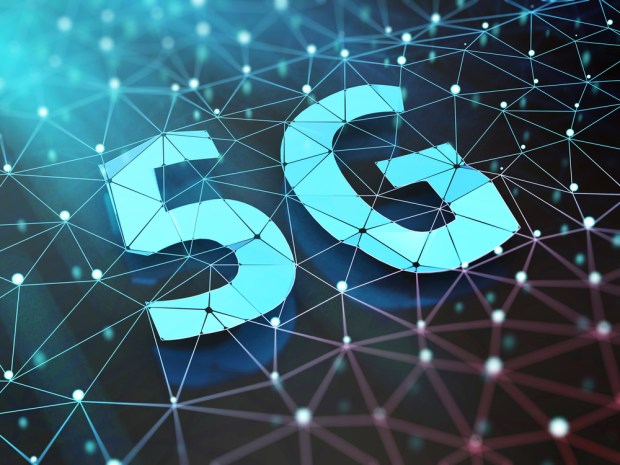5G Retail Possibilities Expand As Mobile Tech Gets Ready To Roll

This is not one of those annoying algebra problems, we promise.
But imagine two long trains, those massive mechanical snakes, each of them gaining speed on the tracks. They are still pretty much a time zone or two apart from one another, but they are gaining speed and moving toward a common connection. No, they won’t collide in a fiery, tangled mess — at least one hopes not. Rather, they will find a way to merge into a single track, their combined energy and mass creating a futuristic super train, one that keeps racing toward that horizon.
In a way, that’s the situation with 5G and digitally enhanced retail right now. Big investment fuels both of those industries, and expectations are increasing — sometimes cautiously, sometimes aggressively — about how the latest mobile infrastructure technology will boost merchant power and give retail operators more ways to reach more consumers, helping to usher in the next generation of eCommerce.
That vision includes significant gaps that will not be filled until 5G technology undergoes significant deployment and early retail use cases emerge. But there is little question that some of the spark behind the money going into 5G — for instance, the $3.5 billion deal that T-Mobile recently signed with Finnish firm Nokia toward “end-to-end 5G technology” — involves optimism over its appeal to merchants, brands and marketers.
5G Retail Pitch
Indeed, that is part of the 5G pitch — its retail capabilities. More specifically, 5G will result in more personalized shopping experiences and more precise marketing data and messaging, as pointed out by AT&T in an example that pretty much matches similar promotional efforts. “In order to collect data and deliver an experience that helps improve sales and create loyal customers, however, retailers need a network with speed, reliability and low latency,” the company said on one of its 5G websites.
Various estimates express the commerce- and payments-related stakes involved in 5G deployment, and a recent analysis from Adobe Digital Insights stands as a relatively reasonable prediction at this point: Over the next three years or so, 5G deployment will result in an additional $12 billion in mobile commerce revenue for U.S. retailers. That, of course, “assumes a smooth, scheduled rollout of 5G networks. Nonetheless, it’s a clear statement that when friction is removed from the user experience, people respond.”
Reducing retail and payments friction stands as one of the key promises of the coming 5G future. “5G is expected to be 10 times faster than 4G LTE speeds, with latency in the single digit milliseconds,” said Lindsay Notwell, senior vice president of 5G strategy and global carrier operations for Cradlepoint, a mobile network services firm.
Mobile Improvements
In his view, 5G will offer a handful of fundamental changes to retailers once that significant deployment happens — some of which are simply improvements upon existing 4G LTE capabilities, while others go beyond that. 5G will enable retail operations to more seamlessly switch to backup networks were the primary one to go down, for example.
Merchants could more quickly open new stores, popups and even kiosks because of the greater strength of a temporary 5G wireless network. 5G also will build upon the security strengths of 4G LTE and further enable merchants “with multiple remote locations to secure sensitive data by creating application-specific, parallel networks,” Notwell said.
More generally, 5G will offer retailers and marketers the ability to send higher-resolution videos to consumers — “viral videos” are part of consumers’ culture these days, and images almost always work to boost purchases and spending, as recent PYMNTS coverage has shown. Video, in fact, makes up half of AT&T’s mobile traffic, Mo Katibeh, chief marketing officer for AT&T Business, recently told a reporter, adding that video traffic over the network increased 75 percent over the last year.
“Technologies such as AI and machine learning offer great potential, but require high bandwidth and low latency to achieve optimal performance,” Katibeh said. “The same is true for technologies like virtual reality and augmented reality, which can offer a customer experience like nothing before.”
Another 5G Train Ride
For a more specific example on that theme, Notwell — in comments that mirror analysis from other experts — imagined another type of train ride, this one on a city subway. “5G will also push forward what’s possible with augmented reality (AR) and virtual reality (VR) technologies,” he said. “Elements of VR already are changing the way people engage with online retail, and 5G will accelerate the trend. How about public transportation? AR could be available for passengers to find restaurants and tourist attractions as they ride through a city.”
That is just some of the retail promise of 5G. The looming deployment of a new technology backed by big money and industry players always gets imaginations going. Those promises have yet to hit the hard rails of commerce and payments reality, but more clarity about where this is all going is sure to come sooner rather than later.
